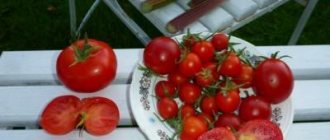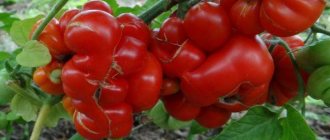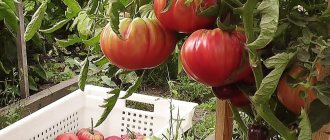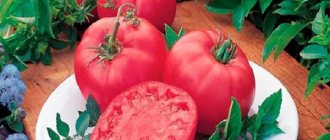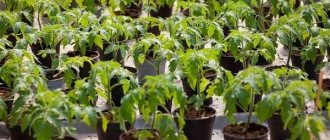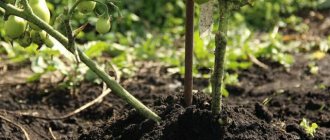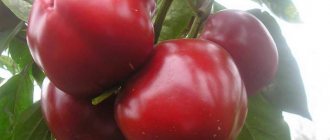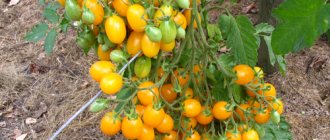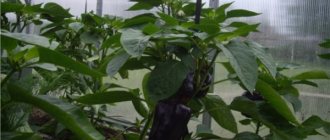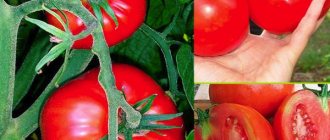Alice's Dream is a young variety from Poland with bicolor fruits, obtained by crossing the Blue Gold and Amethyst Jewel varieties.
| Height | Landing location | Ripening time | Fruit color | Fruit size | Origin | Fruit shape |
| Tall | Greenhouse | Mid-season | Bicolor | Average | Variety | Flat-round |
Description of the variety
The tomato variety Alice's Dream is a new variety - Polish breeder Zbigniew Pauluczek developed it in 2015 by crossing Blue Gold and Amethyst Jewel tomatoes. According to the description of the originator of the variety, the author gave it the following name – Alise’s Dream, which many vegetable growers translate as “Alice’s Dream”.
Description of the bushes
The tomato variety is classified as an indeterminate type; as a result, its shoots are not limited in growth and can grow up to 1.9-2.0 m in height. Since this tomato is quite heat-loving, therefore, in the Moscow region and other regions with similar climatic conditions, Alice’s Dream can only be grown in greenhouse conditions.
Tomatoes of this variety are distinguished by an average period of fruit ripening - after transplanting its seedlings to a permanent place, ripe bicolor fruits are harvested after 2.5 months.
The stems are strong and powerful, medium leafy. Leaf blades are of a characteristic size for tomatoes. They are narrow, oblong, with small sparse jagged edges, dark emerald color
The flowers are collected in racemose inflorescences, each of which can produce up to 10 fruits. If you remove some of the inflorescences, the weight of the remaining ripening fruits in the cluster increases.
The first brush is usually formed under 9-10 true leaves, and each subsequent one - after 2-3 leaves.
Usually tall tomato bushes Alice's Dream have 2-3 shoots, less often - just one.
Description of fruits
The fruits of this tomato are round. slightly flattened, slightly ribbed at the base. The weight of ripe tomatoes is 190-260 g. A special feature of the variety is that larger fruits ripen at the tops of the bushes than at the bottom.
But the main feature of the variety is the color of ripe tomatoes - orange with a yellow tint in the lower part, with wide red stripes at the base and a purple coating on the shoulders. It will be more intense if the fruits were well illuminated by sunlight during the ripening period.
The skin is dense, of medium thickness, so it is practically not prone to cracking. The pulp is juicy, fleshy, has several seed chambers with a small number of seeds.
Particularly noteworthy is the taste of ripe fruits - it is sweet, like most bicolor tomato varieties, which is why the Alice's Dream tomato is classified as a salad tomato.
The harvested crop withstands transportation well at any distance, and does not wrinkle or burst. Ripe fruits can be stored for quite a long time in appropriate conditions.
Varietal characteristics
Description of the variety: indeterminate and tall. Mid-early maturation. When grown in a greenhouse made of film or polycarbonate, it reaches a length of 1.8 meters. Since this plant is not limited in growth, it requires the formation of a bush and garter to a support. The leaves are small, thin, the bush is powerful, branched. When grown in a greenhouse, the bush is formed into 3–4 stems. Plant yield is 4.2 kilograms per square meter.
Large vegetables. On average, one tomato weighs from 300 to 400 grams. The taste is juicy, sweet, the flesh is fleshy, the peel is dense. Therefore, vegetables are resistant to cracking. The tomato is heart-shaped. The color of an unripe vegetable is light green, a ripe one is red. Some fruits have a yellow spot on the stalk when ripe.
Varietal characteristics of fruits - sourness appears in fruits grown in open ground. Since the fruits are large, they tie up not only the bushes, but also the shoots with tomatoes.
This variety of tomatoes is intended for fresh consumption, canning and pickling, preparing fresh tomato juice and sauces.
Characteristics of the variety
It should be remembered that this tomato is heat-loving, so in regions with a cool climate it cannot be grown in garden beds, but only in a greenhouse.
Advantages and disadvantages
The main advantages of the Alice's Dream tomato include:
- pleasant sweet taste of ripe tomatoes;
- fruits are good in summer salads and snacks;
- high resistance to major diseases characteristic of other tomato varieties;
- ripe fruits are not prone to cracking;
- the ability to collect fruits from your own fruits for further planting;
- versatility of fruit use;
- tomato Alice's Dream does not reduce fruiting even in unfavorable conditions.
Among the main disadvantages it should be noted:
- the need for regular stepsoning throughout the summer;
- shoots need to be tied up as they grow;
- in order to get large fruits, it is necessary to fertilize during the summer;
- large fruits are not suitable for whole-fruit canning;
- Some vegetable growers consider the lack of sourness in the taste of fruits to be a rather serious disadvantage.
Productivity
To increase the yield of this tomato, it is recommended to grow it in no more than three shoots, and also to remove some of the flowers in the racemes - then the fruits will be larger.
It is also recommended to spray the bushes of this tomato during the formation of ovaries with fruit formation stimulants - Ovary, Epin, succinic acid, Bud. Then the yield of Alice's Dream tomato will increase.
As a result, up to 5 kg of ripe fruits can be collected from each bush of this tomato.
Growing region
The Alice's Dream tomato is grown in most regions in greenhouse conditions. True, in the southern regions you can grow this tomato in garden beds, where the yield of the variety will be as high as when grown in greenhouse conditions.
Advantages and disadvantages of the variety
Benefits of Alice's Dream tomatoes:
- unusual appearance;
- exotic taste;
- high content of useful compounds;
- the possibility of growing seeds from the harvest;
- resistance to major tomato diseases;
- ability to grow in greenhouses and open ground.
This variety also has disadvantages.:
- seeds are not sold in all stores;
- susceptible to high humidity;
- not suitable for transportation;
- On hot days, the skin of ripe fruits may crack.
About other unusual varieties of tomatoes:
Spectacular appearance and unusual taste: Kumato tomatoes
Tomato "Black bunch F1"
Tomato "Gargamel" and the subtleties of its cultivation
Growing seedlings
This tomato is planted only by seedlings. In this case, seed material for seedlings should be planted approximately a couple of months before transplanting the seedlings to a permanent place. Therefore, the time for planting seeds for seedlings is the first or second ten days of March, depending on the climatic conditions of the growing region.
Preparation of planting material
If the seeds are purchased at a specialized store, they do not require any special pre-planting preparation. It is enough just to soak them in a growth accelerator solution before sowing so that they germinate faster.
If the seed material is collected from your own ripe fruits, then it should be prepared before planting. First, a calibration procedure is carried out to select only high-quality germinating planting material. To do this, the seeds are placed in salt water and only the seed material that has sunk to the bottom of the container is taken for planting.
It is washed and soaked for half an hour in a weak solution of potassium permanganate to disinfect it. Then the seeds are washed and soaked for a day in a growth accelerator solution for germination. After all the procedures have been completed, the seed material is ready for planting in the container.
Preparing containers and soil
The containers must be wide and long enough, with low sides, and in the bottom of each of them there must be drainage holes into which excess moisture will drain.
Before use, containers must be disinfected using special means.
It is best to purchase a nutrient substrate for planting tomato seeds for seedlings in gardening stores - where such soil has already been prepared in a special way: fertilizers and the necessary components have been added to make it loose. The purchased soil mixture has already been disinfected and contains no pathogenic microorganisms, harmful insects and their larvae.
But many vegetable growers prepare the soil for planting seedlings themselves at home. To do this, they mix equal parts of turf soil from the garden, high-moor peat and rotted manure (or high-quality compost). Rotted sawdust is added to the resulting mixture (500 g for every 10 kg of the mixture) to give it looseness.
Important! Sawdust can be replaced with river sand.
All ingredients are thoroughly mixed and disinfected using one of the following methods:
- steam for 30 minutes in a water bath;
- the oven is heated to 180С, the soil mixture is placed in it for half an hour;
- spilled with a weak solution of potassium permanganate.
Each vegetable grower chooses his own method of soil disinfection. It is only important that after any such treatment no pathogenic microorganisms or harmful insects remain in the soil.
Then the prepared soil is laid out in containers, and you can begin sowing the seed material.
Sowing seeds
The surface of the soil is moistened, and only then the seeds are laid out on it in rows, and the distance between the rows should be at least 2.5 cm. A layer of soil 1 cm thick is poured on top and it is moistened with a spray bottle so that the seeds are not washed out.
Then the containers are covered with glass on top to create a greenhouse effect inside - this way the seeds will germinate faster.
Important! Before emergence, containers should be kept in a room with an air temperature of about 25°C.
After friendly shoots appear in the containers, the glass is removed from them, and the plants themselves are transferred to a well-lit place.
Seedling care
Further care for Alice's Dream tomato seedlings includes standard procedures:
- watering;
- feeding;
- picking;
- hardening.
Water the seedlings regularly and moderately as the top layer of soil dries. Water for irrigation should be filtered and warm. Cold water can cause seedlings to develop blackleg.
After the seedlings have several true leaves, they should be planted in separate pots. The transplant is carried out carefully so as not to damage the fragile roots.
In new containers, seedlings acclimatize in about a couple of weeks, and during this time they can be fed with any nitrogen-containing fertilizer. Similar feeding is repeated after a couple of weeks, but no later than 12-14 days before planting in a permanent place.
If the plants begin to stretch out, it means they do not have enough natural light. In this case, fluorescent lamps are installed next to the seedlings, which are turned on in the early morning, in the evening hours and on cloudy days.
10 days before transplanting tomato seedlings to a permanent place, you need to take them out into fresh air for hardening. At first, the seedlings are outside for no more than an hour, but gradually this time increases. And in the last days before planting, the seedlings can be left outside overnight.
Tomato Alice's Dream. Description
- September 20, 2022 12:00:00
Breeders never cease to please professional gardeners and those who like to grow their own tomatoes by developing new tomato varieties with extraordinary qualities.
The modern seed market offers the exotic tomato Alice's dream. Tomato seeds are obtained by cross-pollination of Blue Gold and Amethyst Jewel tomatoes. It was bred and first grown in Poland in 2015, so it did not gain much popularity, but it has established itself as a vegetable with a unique set of characteristics.
You can’t buy seeds at every gardening store. The tomato is not included in the register and is considered a collectible. To get high-quality planting material, you need to contact us. Only on our website you can order rare varieties of vegetables at affordable prices.
Characteristics of the tomato variety “Alice’s Dream”
In the original source, the tomatoes are called Alice's Dream (literally, Alice's dream). They are distinguished by an extraordinary range of nutrients, exotic appearance and simple requirements for growing conditions. Description of Alice's dream tomato:
- heat-loving bush, 1.5-2 meters high;
- resistant to major diseases (since the variety is new, these claims have not been proven);
- fruits are placed in clusters of 8-10 pieces (on average 3-5 clusters per bush);
- thin-skinned fruits of medium size weighing 150-250 grams (up to 5 kg per bush with an average harvest);
- the pulp is juicy, low density, with multiple chambers filled with juice or grains;
- Sugar fruits with low acid content.
The vegetable is not subject to transportation, long-term storage or preservation.
Features of the exclusive tomato variety “Alice’s Dream”
The salad vegetable, which is consumed exclusively fresh, has features that clearly distinguish it from ordinary tomato varieties:
- a color that from a distance resembles a fig, a tricolor of red, yellow and purple;
- complex taste with notes of citrus;
- high content of anthocyanin - a glycoside that has a positive effect on intestinal motility and counteracts inflammatory processes;
- Plants like moderate watering and do not tolerate extreme temperatures above zero.
The bushes should be watered as the soil dries; in the southern regions, during the peak of the heat, you can cover the fruits with a shading net.
If you want to cultivate Alice’s dream tomato, which has the most positive reviews, you can purchase planting material on our website. We will offer you the best seeds at affordable prices.
Growing methods
Alice's dream tomato, a photo of which can be seen on our website, is a mid-ripening variety grown in different conditions.
Sowing of seeds is carried out in open ground or in seedlings.
Seedlings begin to germinate 1.5-2 months before planting on open plantations. In the southern regions, sprouts are planted from the beginning of May to the first half of June. For a larger harvest, the soil is pre-prepared - stove ash, organic fertilizers and river sand are added.
Planting is done in open soil in a checkerboard pattern, in 10-15 cm holes at the rate of 4 bushes per 1 square meter.
Alice's Dream sprouts are systematically fed with organic and mineral solutions 2-4 times per season. Loosen the soil and be sure to tie up the stems.
Buy tomato seeds “Alice’s Dream”
If you have a desire to buy Alice's dream tomato, then you can contact us. The search for planting material will be simplified, and you will be able to quickly obtain high-quality and original seeds for planting on your own plot.
The site offers a wide range of new cultivated plants that have not yet gained popularity due to their novelty. We post only reliable information about the plants presented with a description of the most detailed characteristics and properties of the crops. We provide photos of the harvests of all garden plants.
When purchasing any batch of seeds, customers receive an excellent product and top-class service. Contact experienced specialists for planting material!
Growing tomatoes
Growing Alice's Dream tomato is quite easy - you must not forget about regular watering and frequent fertilization, because this variety is demanding on soil fertility. But we must not forget about tying up tall shoots and regularly removing emerging shoots.
Planting seedlings in the ground
The soil on the site should be prepared in advance - remove all remnants of vegetation, add organic matter, dig, while fertilizers are embedded in the soil. In a greenhouse, it is advisable to remove the top layer of soil and replace it with fresh, fertile and loose soil. If such a replacement does not work out, then you need to spill all the soil in the greenhouse with a pink solution of potassium permanganate, apply fertilizer and dig up the area, incorporating fertilizer into the soil.
It is advisable to plant no more than 3 Alice’s Dream tomato bushes on each square of area. In this case, the plants will not interfere with each other’s growth, and they will have enough nutrients in the soil for growth and active fruiting.
A handful of complex mineral fertilizer is placed at the bottom of each hole, and a thin layer of earth is placed on top. A tomato seedling along with a ball of earth is placed in the center of the hole, the hole is filled with soil, and watering is carried out. A layer of mulch 4-5 cm thick is added to the root zone from above. Straw, mown grass or humus can be used as mulch.
Differences between growing in a greenhouse and open ground
In a greenhouse, the conditions for the growth and fruiting of this tomato variety will be more comfortable, since this tomato is heat-loving and does not tolerate sudden temperature fluctuations.
But in the greenhouse you will have to constantly monitor the humidity level and constantly ventilate it. Also, indoor plants may not have enough lighting and will have to install additional lighting there.
In addition, you need to take into account that the Alice’s Dream tomato bushes are tall - up to 2 m in height, respectively, the greenhouse should be no lower than this value.
But the basic requirements for caring for this tomato bushes remain the same: watering, fertilizing, forming bushes, tying up shoots, loosening the soil and removing weeds.
Tomato care
Further care for tomatoes includes the following agrotechnical procedures:
- compliance with the irrigation regime;
- fertilizing;
- loosening and removal of weeds;
- mulching;
- formation of bushes;
- removal of stepsons;
- timely harvest.
Tomatoes Alice's Dream on video
Evpator tomato reviews photos
If you grew Alice's Dream tomatoes, please write whether you liked them or not. What was the yield and taste of the fruit under your conditions? Briefly describe the advantages and disadvantages of this tomato in your opinion. If possible, attach a photo of the entire bush or individual fruits you grew to your comment. Thank you!
Your reviews of the Alice's Dream tomato and additions to the description will help many gardeners evaluate this variety more objectively and decide whether it is worth planting or not.
Alice's Dream is a tomato with a very exotic color - bicolor with anthocyanin shoulders and an unusually pleasant sweet taste, almost no sourness!
Alice's Dream
The variety is relatively new, bred by Polish breeders in 2015. The plant is indeterminate, quite tall. In terms of ripening time, the variety is classified as mid-season. I have Alice’s Dream growing both in a greenhouse and in an outdoor garden bed. These tomatoes are formed into two stems. In the greenhouse, the fruits were not large, about 150-200 g, with denser pulp, but less pronounced anthocyanin. Street ones are larger, brighter in color, juicier in flesh.
In the seedling period, they were not capricious, not prone to stretching, and were distinguished by the beautiful emerald green color of the leaves and the lilac tint of the stem. After landing, they bravely endured quite serious cold snaps and further temperature changes.
Alice's Dream
This tomato has very interesting brushes - complex, branched. This year I didn’t limit it, I observed it, but next year I want to try to form a cluster, I want to see how this will affect the size of the fruit.
Alice's Dream
Summer this year did not spoil us with many sunny days, but in the open ground it was enough for the fruits to show their beautiful colors!
Alice's Dream And of course, one cannot fail to mention the main thing - its magnificent, unusual taste! Delicate, sweet, but not cloying, and seemingly with a light fruity note... mmmmm...
Alice's Dream
Of course, we don’t think about any preparations - we eat it fresh! It never even ended up in the salad - just cut it and eat it! No salt, no oil... nothing should disturb the harmony of its taste!
Nuances of cultivation
When caring for this tomato, it is important to regularly water the plants every 3-4 days with warm water, strictly at the root. During the dry season, the amount of watering is increased, and during the rainy season, the number of waterings is reduced.
Fertilizers are applied to tomato beds regularly at intervals of 10-12 days. Typically, complex mineral fertilizers are applied to the soil, alternating them with organic matter: an infusion of bird droppings or cow manure. You can also use an infusion of green grass as a top dressing.
It is also important to form bushes with no more than 3 stems. To do this, leave one or two stepsons that grew under the first inflorescence - the side shoots will grow from them.
Tall stems need to be tied to strong supports when growing in garden beds; in greenhouses, before planting seedlings, it is advisable to install trellises to which the Alice's Dream tomato bushes will be tied.
Important! All other stepsons should be removed as they appear.
After watering and rain, the root zone of the tomato needs to be loosened, simultaneously removing weeds, and also covered with a layer of mulch so that moisture from the soil evaporates more slowly.
How to grow seedlings
Preparing seedlings is simple; the main thing is to know the basic rules for growing them. As a rule, it is recommended to sow seeds 50-60 days before planting plants in the ground. To do this, select the appropriate seed, container and soil.
Seed preparation
When purchasing seeds, pay attention to the reputation of the manufacturer, and not to the bright and beautiful packaging. Study customer reviews or recommendations from neighboring gardeners and only then choose the right supplier
We do not recommend buying material in unverified places; it is best to contact specialized stores.
After purchasing, the seeds must be disinfected. This is done using aloe juice, hydrogen peroxide or a solution of potassium permanganate. Soak the seeds in one of the solutions for 24 hours, then place them on a cloth and dry well. Disinfection is a mandatory stage of seed preparation; it destroys dangerous microorganisms on the surface of planting material.
The next stage is hardening. Place the seeds in the freezer overnight and then leave them in the room for 10 hours. Repeat the algorithm several times and be sure that the plant will not be afraid of cold weather in the future.
After hardening, many gardeners germinate the seeds - place them in a damp cotton pad and leave in a dark place for 5-7 days. It is believed that with the help of germination, the general germination of seeds is checked and their immunity is strengthened.
Container and soil
Good soil should be loose and nutritious and meet the required acidity level. In addition, the soil must be well permeable to water and moisture.
The composition of humus and chernozem in a ratio of 2:1 is recognized as an excellent mixture. For drainage, add 1 part of river sand or sawdust to such soil.
Any containers can be used: plastic cassettes, peat pots, plastic disposable cups, and so on.
Wash the container well and dry it, then treat it with hydrogen peroxide.
Sowing
Before sowing, make a drainage layer at the bottom of the container. This simple operation protects seedlings from root rot and blackleg. After drainage, pour the prepared soil into the container and water with warm water. Cover the container with film or thin glass and leave for 5-6 hours.
Then use a pencil or toothpick to make small holes in which to place the seeds. Sprinkle the grooves with soil, pressing down lightly. Use a spray bottle to moisten the grooves and cover the seedlings with film.
Growing and care
The seedlings are kept in a warm and bright place. The first week the air temperature should be at least 23 degrees. As soon as the sprouts have sprouted, the film is removed. Water the seedlings with warm filtered water as the soil dries
It is important to avoid excess moisture, as this leads to the risk of fungal infection.
After 7-10 days, the air temperature is reduced to 19 degrees Celsius. Regular ventilation is also necessary. After 2 weeks of planting seedlings in the ground, the container is taken out to the balcony for 1-2 hours, subsequently increasing the time. This way the seedlings are hardened off.
Seedlings must be fed. Ideally, combine mineral and organic fertilizers. Among organics, nettle solution or ash are considered an excellent remedy; among mineral complexes, it is recommended to use “Fitosporin+” or “Baikal”.
Diseases and pests
The Alice's Dream tomato is highly resistant to most diseases characteristic of this vegetable crop. It is also practically not affected by harmful insects.
Disease and pest control
Since the Alice's Dream tomato has high immunity, it practically does not get sick, and pests do not settle on it. Therefore, vegetable growers will not have to fight pathogenic microorganisms.
Preventative treatment
But many diseases can affect any tomato bushes due to non-compliance with care rules. Therefore, for the purpose of prevention, it is necessary to observe the irrigation regime, monitor the level of humidity and light in greenhouses, and carry out regular ventilation.
It is also important to remove all weeds on the site - after all, it is in it that harmful insects can hide, which can also be carriers of various infections.
Before planting tomatoes, it is advisable to spill the soil with a disinfectant solution, and in the fall, be sure to dig it up with a shovel so that all the pests and their larvae, hidden in the soil for the winter, come to the surface and freeze in the cold.
Best reviews from our readers
- Miroshnichenko Elena
Cool large-fruited tomato. Delicious, juicy, sweet. And how beautiful! It bears fruit for a long time. - Alexei
Excellent variety! The bush was about 180 cm. It led into two stems. The fruits are tasty and beautiful, on average 150-250 g. The yield is quite good. I wasn't sick.
- Svetlana
Hello everybody! For the first time I am growing Alice's Dream, and on the street. Of course, I cover it at night with agrotextile 40. The abundance of ovaries is amazing! Up to 10 pieces per brush, large, beautiful, up to 4 brushes per plant! Unpretentious: watering is rare, they don’t get sick! The only thing I can’t rate is the taste! Not ripe!
Bushes that do not stretch uncontrollably upward, but are capable of timely self-restraint, are very convenient to grow. At the same time, its respectable height determines excellent productivity indicators. Its versatility is also attractive: it can be planted anywhere. True, in open ground you will need supports, but not very high ones.
Semi-determinate varieties, as a rule, are not too late, usually mid-early or mid-ripening. But you still need to step them up. In the open air, some varieties may require topping towards the end of the season (on average - early August). The standard height is from one to 1.5 (and a little higher) meters (this is observed in a greenhouse).
Tomato Eagle beak
Large, fast, productive
A wonderful variety in all respects. Created by the work of a team of famous Siberian breeders (V.N. Dederko, T.N. Postnikova, A.A. Yabrov). The variety has a state patent and has been listed in the register since 2005. Medium early in terms of ripening. The plant develops at a rapid pace: seedlings produce real leaves early and quickly grow ovaries.
Tomato Southern tan
The sweetest
The patented original variety of Dederko and Postnikova has been registered in the state register since 2007. Similar to the Golden Koenigsberg (of the same authors), which does not have a patent and is not included in the register. The powerful bush of the plant requires obligatory pinching. The harvest is high, 7.7 kg per bush was collected. Tomatoes are oval with a spout, smooth, weighing 150-170 g;
Sugary raspberry
Mid-season tomato with high adaptive abilities. Tolerant to diseases and temperature changes. But with sharp fluctuations in humidity and excess dampness in the soil, it can burst. However, on the other hand, regular watering is necessary. Responsive to any feeding. The fruits are an appetizing dark crimson color.
The watermelon pulp is sugary. The weight of tomatoes is from 290 to 560 grams and even more. The variety of these vegetables was included in the register in 2007. The bush is about 1.5 meters high, the leaves are large, dark green. The inflorescence is simple. It requires tying the plant to a support and pinching. The best results were obtained when forming a bush with 2 stems. The second trunk is the stepson, located below the first flower cluster. The remaining side shoots must be removed
Tomato Honey saved
Unpretentious and sweet
A flexible Siberian variety, easily adaptable to temperature changes: from high to low and vice versa. Tested and reliable. Ripening period is average, purpose: processing is encouraged, it better accentuates the taste in salads. In closed ground it can produce up to 5 kg. from one bush. Tomatoes are classic heart-shaped, smooth, beautiful.
When fully ripe they turn a deep orange color. Most of the crop ripens well on the vine, the rest of the fruits ripen well. They are characterized by excellent transportability and shelf-life. The weight of the fruit in the lower clusters reaches 420-530 g, closer to the top - 150-200 g. The pulp is tasty, sweet, and medicinal. Registered in the state register since 2005.
Tomato Pink Elephant
Sugary pink
In terms of ripening time, this popular variety is classified as mid-early. Included in the state register in 1998. Recommended for growing under film covers in all regions of the Russian Federation. The variety is not intended for industrial cultivation, but is appreciated by owners of small garden plots. The foliage is almost similar to potato tops.
Tomato Persimmon
Carotene piggy bank
In 1999, a variety created at the Moscow Timiryazev Academy based on varieties of folk selection type was entered into the state register. An interesting hybrid that combines many qualities: external beauty, taste and productivity. Medium-early in terms of timing (110-115 days), with prolonged fruiting.
The bushes are not too spreading, with dense large foliage. The first inflorescence emerges above the 7th leaf. There are from 3 to 4 tomatoes in a bunch - round, slightly ribbed, deep orange, weighing 230-360 g. The pulp is juicy. The taste has an aromatic sourness. The main value of the variety is the highest content of carotenoid vitamins. Vegetable yields are moderate.
Tomato Bull's forehead
Large and unpretentious
The variety adapts perfectly to greenhouse heat and street cold. Brings a decent harvest even when the year is unfavorable for growing - up to two buckets from 1 square. Tomatoes are round, slightly flattened, ribbed. Weight 0.5 kg or more. The pulp is dense. The ripening period is average; In open ground, about half of the fruits ripen.
Folk selection
Registered in the state register in 2001. An old variety of folk selection, packaged by different companies. Mid-season salad tomato. Tomatoes are round, flattened, moderately ribbed, sunny orange in color. They are meaty and sweet. There are 2-3 fruits in 1 kg. Record weight 700 g.
It has a rare quality for a meaty variety - it is resistant to cracking. From 1 square meter you can collect up to 1.5 buckets of fruit. Orange tomatoes contain much more beta-carotene than other groups of varieties of different colors. Therefore, these tomatoes are extremely popular among gardeners. The Orange Giant tomato is famous for its high yield and excellent taste.
Tomato Bugai red
Heavyweight
The newest variety (in the register since 2014) with self-limiting growth to 1.5 m. Ripening period - mid-early, with a long fruiting period. Large, flat, round tomatoes with an intense pink color ripen on the bush. The weight of the fruit reaches 600 g. Tomatoes have dense pulp, sugary at the break; the chambers contain a small amount of seeds.
Tomato Nonna M
Cordate
The newest mid-early variation of the Bull's Heart in the Siberian format. The raspberry-pink fruits are at once large, elegantly beautiful, and have a sugary taste and twist. Medium-early, from germination to the beginning of ripening 110-115 days. The plant is strong, 1.2-1.8 m high, depending on growing conditions. The fruits are elongated, heart-shaped, raspberry-pink, with a moiré tint, weighing 400-700 g.
Tomato Superbomb
The promise of record harvests
The mid-season new product promises a decent yield in open ground. The innovative Superbomb tomato is successfully grown in various regions of the country. It is not afraid of intense heat, scorching sun, and dry air. Fruit set remains consistently at a high level. The Superbomb tomato needs increased nutrition and moderate pruning. There are 5-6 tomatoes in a bunch, weighing 300-600 g. They are fleshy, rounded and flattened. The plant is compact, with self-limiting growth.
Tomato Puzata Khata
Unique shape
An original new variety from agro, on the state register since 2013. For lovers of unusual tomatoes. The variety is early (105 days is not uncommon), with extended yield and a total yield of 9.6 kg per 1 square. Tomatoes have an interesting pear shape with pronounced ribs. Fruit weight 185-270 g. Purpose: salad.
Harvesting and application
The fruits are collected as they ripen. Since this tomato is grown in greenhouse conditions in most Russian regions, all fruits that have set usually ripen successfully on the bushes.
Harvested tomatoes are usually used fresh, as they have a pleasant sweet taste - they can be added to summer salads and a variety of snacks. They also make delicious preparations for the winter - lecho, ketchup, tomato paste and thick juice. But due to the large size of the fruits, they are not suitable for whole-fruit canning.
Description
An early ripening indeterminate hybrid, “Dream” was created for film greenhouses. It can be grown literally in any corner of Russia, including the circumpolar and polar zones.
Fruits weigh 180-220 g, flat-round in shape, with unpronounced ribbing. The color of ripe fruits is red, at the stage of technical maturity it is light green. The tomatoes are fleshy: there are almost no seeds on the cut. 4-6 nests are formed on the bush. Each cluster with complete pollination contains 6-7 fruits. Tomatoes of this variety tolerate transportation well and have high taste characteristics: they taste sweet, while harmonizing well with other vegetables without overwhelming them. The hybrid bears fruit from July to September. The yield ranges from 16 to 18 kg per square meter.
Reviews
Maria, 50 years old, Moscow region: I accidentally purchased seeds of this variety in a specialized store when I was buying other seed material in the spring. I grew Alice's Dream tomato seedlings and planted them in a greenhouse, since the description said that the variety is heat-loving. We collected the first ripe fruits 2.5 months after planting the seedlings in the greenhouse. Although up to 10 fruits were formed on the shoots in the clusters, I removed some of the ovaries so that no more than 5 fruits remained in each cluster. As a result, the weight of all the collected tomatoes was about 200-220 g. From the harvested crop, I used tomato paste and ketchup for the winter, and left the rest of the fruits for summer salads. The taste of tomatoes is excellent, so I will continue to plant this tomato variety.
Natalya, 45 years old, Barnaul: in our unpredictable climate, we grow most vegetable crops in greenhouses. Last season I also planted Alice’s Dream tomato seedlings bought at the market there. There were only 10 bushes, which quickly grew and produced an excellent harvest of fruits with original fruit colors - up to 5 kg from each plant. But during the growth process, it was necessary to constantly fertilize the bed with this tomato, and also constantly remove the stepsons. The fruits are very tasty and juicy, everyone in my family really liked them.
Review of reviews about Alice
The variety is popular in Russia and has received positive reviews from gardeners.
Let's look at some of them. Olga: “The fruits began to ripen early, the bushes are tall, so it is better to plant them in a greenhouse. To prevent the bushes from becoming infected with fusarium after the dew appeared, I sprayed them with a serum solution every week. Thus, the bushes bore fruit until autumn. The taste of the fruit is excellent, there is a tomato aroma, they are sweet, suitable for making tomato juice.”
Dmitry: “I’ve been growing tomatoes for more than 20 years, every year I try to find seeds of new varieties, last year I came across Alice’s seeds. I planted them in a greenhouse and they grow just like regular tomatoes. But the fruits are beautiful, heart-shaped, red. There are no spots on the fruits after ripening. Colored evenly and beautifully. Useful for salads and wraps. I'm happy with everything."
Photo
The Alice's Dream tomato, although it is the fruit of foreign selection, has already taken root well in Russia - it was appreciated by Russian vegetable growers who grew this tomato in their beds and were satisfied with the yield and relative unpretentiousness of the variety.
Farmer reviews
Reviews from farmers who have tried Alice's Dream tomato are positive .
Gardeners say they will grow this tomato again. Marina Irtyscheva, Nikopol : “I ordered Alisa’s Dream seeds online. Last year I planted several seeds. Everything has sprouted. There were no problems with caring for the tomatoes; they did not get sick. The tomatoes turned out unusual: orange, with red stripes and brown spots. They taste very sweet. An excellent tomato variety. From the collected fruits I prepared seeds for further cultivation.”
Alisa Kryukova, Voronezh : “I grew Alisa’s Dream tomato in open ground. Rather, I would classify it as early ripening. The first year of my acquaintance with this variety was rainy, and the fruits were not very sweet. The next time I liked the taste of berries better.”
Varieties and hybrids of tomatoes
According to the structure of the bushes, tomatoes are divided into:
- non-standard;
- standard;
- potato-shaped.
Non-standard ones are distinguished by thinner stems that lie down during the fruiting period, as well as large, slightly corrugated leaves.
Standard tomatoes are distinguished by compact bushes with fairly thick stems, strongly corrugated leaves, medium in size, with short petioles.
Potato-shaped (large-leaved) tomatoes are quite rare, and they are called so because of the leaves, which are shaped like potato leaves.
Hybrid tomatoes are virtually guaranteed to be resistant to diseases and bad weather conditions, which is something that non-hybrid varieties suffer from. Greenhouses and greenhouses are valued for storing heat, but in them tomatoes can suffer from too high temperatures and sudden temperature changes. In recent years, world selection has been aimed at producing “heat-resistant” hybrids with a reliable guarantee of ovary production.
Hybrids are especially helpful in a greenhouse or a small garden plot where there are no real opportunities for crop rotation and diseases are prevalent. Selection successes demonstrate confident resistance to various types of infections - viral (especially the most dangerous tobacco mosaic virus), fungal, bacterial. In addition, the hybrids have uniform fruits and consistently high yields.
Tomato Incas F1
One of the best hybrids for canning whole fruits without skin. Popular early high-yielding bush hybrid. The plant is medium-sized, compact.
Tomato from the Dutch company Numens, zoned in Russia; entered into the state register in 2000. Mid-early hybrid (105 days) of meter-high vegetables, determinate. Very high resistance to fungal diseases has been recorded. The fruits are 80-100 g, dense, bright red, pepper-shaped, fleshy, uniform, tolerate sunburn well, are very easy to ripen, transported over long distances without loss of quality.
Tomato Torquay F1
Dutch hybrid from Bejo Zaden; in the Russian register since 2007. Mid-season tomato (119-123 days from germination to ripening), bush type - determinate, maximum height 100 cm. Forms abundant multiple clusters with fruits weighing 60-140 g. Dense tomatoes withstand long-term transportation, excellent in pickling and pickling matters.
Tomato Mariana F1
The tomato was created in the French branch of the Japanese company Sakata (the image of the woman Mariana is a symbol of the French Republic). The breeders of this agricultural company are often suspected of producing GMOs, but so far without real evidence. Mariana is a mid-early determinate hybrid. The fruits are similar in shape to Incas - also elongated-oval, perfectly smooth, super dense.
Tomato Bagheera F1
Hybrid from the leading French seed company Cloz. Included in the Russian seed register in 2007.
Early high-yielding hybrids are a real boon for the garden. They are cold-resistant, do not need pinching or tying up, and practically do not get sick. The ripening period is marked as medium-early; determinate bush. The fruit is round, flattened on top, ribbed, weight ranges from 80-220 g. The hybrid is resistant to soil drought and nematode, more suitable for regions located in the south. Does not suffer from fusarium and verticillium wilt.
Tomato F1 Semko 2005
The tomato is suitable for open ground and under film shelters (greenhouses). Determinate, medium-sized, compact. Resistant to soil salinity, drought, high temperatures, grows well in open ground in both southern and northern regions. Vegetables practically do not suffer from viral and fungal diseases, even late blight.
Tomato F1 Semko 2010
Included in the state register in 2010. Ultra-early ripening determinate hybrid - 85-88 days pass from the sprouting of green vegetables to the coloring of fruits. The first brush is formed immediately after the sixth leaf grows. The fruits are incredibly dense for such an early tomato, and are by no means small - 130 g. The shape is round hearts with a beautiful pointed tip.
In open ground, we usually plant thickly - 5-6 bushes per square. The best harvest from such an area is at least a bucket. The hybrid is highly resistant to bacteria, fungi and viruses. Does not crack and does not suffer from blossom end rot. Successfully withstands high temperatures and dry soil.
The newest indeterminate hybrid (on the register since 2015) - tested by us, everything is fine - created taking into account all possible greenhouse disasters. Firstly, it sets well even in the heat, as well as during temperature changes. Secondly, it is tolerant of problematic soil substrates. Thirdly, it shows high resistance to viral, fungal and bacterial infections.
The yield of vegetables varies between 20-30 kg/1 square meter. Mid-early hybrid (100 days from green shoots). The clusters begin to form after 7-9 leaves, each bears 5-6 tomatoes in the shape of rounded hearts, smooth, beautiful, attractive orange color. The weight of the “heart” is 160-190 g. The pulp contains a high percentage of dry matter, sugars, and carotenoids.
Bushes of unlimited growth, with dense foliage. Mandatory shaping is required, including a garter. Hybrid of medium early or medium ripening period (112-118 days). Clusters of 6-8 tomatoes weighing 130-150 g. The fruits are plum-shaped, slightly tapering downwards. They are deep red in color, thick-skinned, with a high percentage of dry matter.
Tomato Empire F1
Indeterminate hybrid of a new generation, in the state register since 2011. Medium-early (100 days - 2 days - from germination). The plant is tall, much taller than other types of tomatoes. Therefore, the tomato requires gartering and pinching. Tomatoes are oval-shaped with a spout, weight ranges from 80 to 140 g. On average, 9 kg are obtained per bush. The color of the fruit is red-orange. The skin and pulp are dense. Can be stored for 6-7 weeks. In greenhouses people do not suffer from viral and fungal infections.
On the register since 2015. The bushes are semi-determinate, beautiful, a meter and a half high. Suitable for any soil - open or closed. Plants require pinching. Multiple clusters bear up to 30 fruits with a sweet taste and a perfect “strawberry” shape. Weight is typical for classic cherry tomatoes - 25 g.
Tomato F1 Kaspar
The bush is short, usually up to the first cluster, 60 cm. The fruits of the plants are cylindrical with a spout, the length varies around 11 cm, and the weight is 95-115 g. They are very dense, without juice. It is convenient to pickle them assorted with cucumbers of a similar size.
The average ripening period is 115 days. The hybrid is intended for open ground, or is planted under low shelters; We plant three to four vegetable bushes per square.
Tomato Aunt Valya F1
Valya f1 tomatoes are early-ripening, tall hybrids with average yield. The bushes easily and quickly reach a height of 200 cm. In the register since 2015. Productivity is within 20 kg per square meter. On average, one bush produces 7 kg of tasty and beautiful tomatoes. Tomatoes ripen simultaneously, reaching 200-250 g in weight.
The fruits have a regular round, slightly oblong shape. The scope of use of tomatoes is very wide. Salads are prepared from the first fruits. As the volume of the harvest increases, the fruits are used for winter harvesting, as well as juices, ketchups, pastes, sauces and lecho. Tomatoes retain commercial quality for a long time and tolerate transportation and long-term storage well.
Differences between tomato varieties
Each tomato variety has its own personality. Behind each are years of work by breeders and decades of popular selection. The beauty of the best modern tomato varieties is their diversity. So we “exploit” tomato hybrids and varieties with unlimited growth - indeterminate, semi-determinate, and determinate, the average height of which for the most part ranges from 70-80 cm, and low-growing vegetables, whose height does not exceed half a meter (all of them We will discuss the differences and features in the article below).
You cannot give advice based on outside experience, as some do, deliberately introducing not entirely truthful information about the yield (quantity and quality) of grown tomatoes. They say here they are - the best varieties of tomatoes of the past (and, further, in descending numbers) for tomatoes of the year. With everything, however, it should be noted that they often focus on plant varieties proposed for planting for open and closed ground, without understanding that the advice will be good only after personal experience - better after at least 3-4 years (honestly, but extremely rarely , and 2 are sometimes enough) and with meticulous experiments (starting with growing seedlings using the soil additive Vermiculite, the growth stimulator Gumi and, ending with fertilizing: magnesium sulfate, mineral fertilizer Fertika-Kemira and so on - already in the garden) for each variety.
Why am I giving such a deadline? Yes, because you definitely need to take into account the weather, which differs from year to year, and this is the minimum, in my opinion, period to have more or less an idea about each variety of tomatoes.
